Green heating system is centrepiece of cathedral restoration
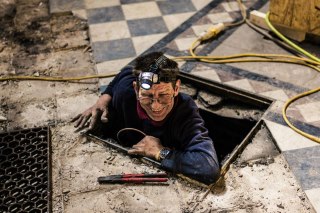 In April contractors moved into Manchester Cathedral to begin installation of a new underfloor heating system. The new system will employ ground source heat pumps designed which will draw heat from the ground under the cathedral via bore holes.
In April contractors moved into Manchester Cathedral to begin installation of a new underfloor heating system. The new system will employ ground source heat pumps designed which will draw heat from the ground under the cathedral via bore holes.
The resulting system will make the cathedral one of the greenest in the country.
Over recent years levels of heating in the building have fallen below what is required in modern times, partly due to the deterioration of the underfloor pipework.
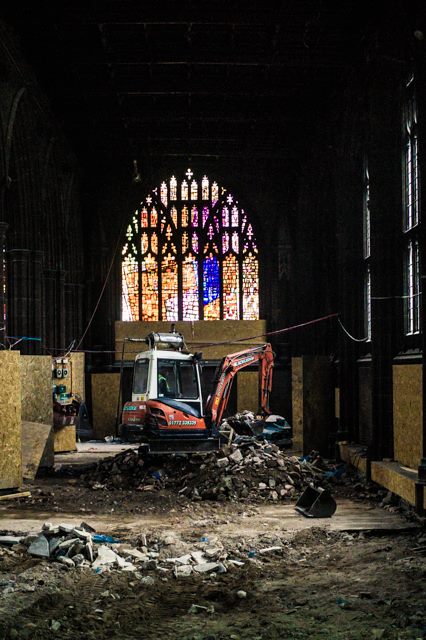 The current underfloor heating system dates from the post-war rebuilding era of the 1950s. In the last past years there have been three incidents of the heating flooding the Cathedral floor, as a result the heating output now is around 60% of the levels they should be.
The current underfloor heating system dates from the post-war rebuilding era of the 1950s. In the last past years there have been three incidents of the heating flooding the Cathedral floor, as a result the heating output now is around 60% of the levels they should be.
The Dean of Manchester, the Very Revd Rogers Govender, said: “Levels of heat are very important for both visitors and worshippers alike. The recent extremely cold winters have embarrassed the cathedral as temperatures were unacceptably low. We’re incredibly pleased that we can carry out this work in a sustainable and responsible way, ensuring the cathedral is fit for future”
The work is being overseen by the architects Lloyd Evans Prichard, who said: “Records held at the cathedral indicated that in 1888 a review of the cathedral floors was undertaken to address the odour emanating from past burials. The re-ordering of the cathedral in the late Victorian period was a substantial project that entailed major alterations to the floor.”
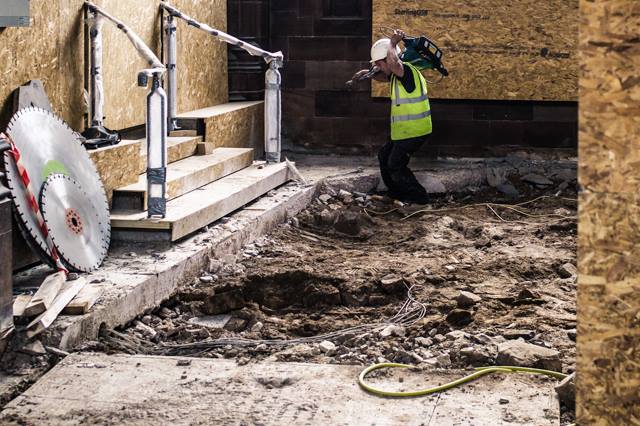 The current project will involve replacing the floors in the nave, the quire aisles and the Regimental, Fraser and Lady Chapels. According to contractors Lambert Walker: “At present, this largely consists of a stone paved concrete floor, which will be replaced with limestone paving and parquet flooring in the Regiment and Fraser Chapels.”
The current project will involve replacing the floors in the nave, the quire aisles and the Regimental, Fraser and Lady Chapels. According to contractors Lambert Walker: “At present, this largely consists of a stone paved concrete floor, which will be replaced with limestone paving and parquet flooring in the Regiment and Fraser Chapels.”
The architects continued: “The trial excavations reflected the build-up of the floor since the reordering of the late 1800s and revealed that much of the visible finish and immediate substrate of the floor had been substantially altered in the last 150 years.
“The design of the proposed floor aimed to minimise the depth of excavation that would be necessary to accommodate the new floor. Minimising the depth of excavation limited the potential for encountering ground not disturbed since the late 1800s. The avoidance of undisturbed archaeology was an important consideration for the project for both time and cost constraint reasons.”
The existing floor finishes have all been assessed by Clare Hartwell of Architectural History Practice, and all areas to be replaced were found to be of low significance. The cathedral has also carried out investigations into likely archaeological disturbance with Norman Redhead, Cathedral Archaeologist, and has drawn up methods to deal with any discoveries during the work.
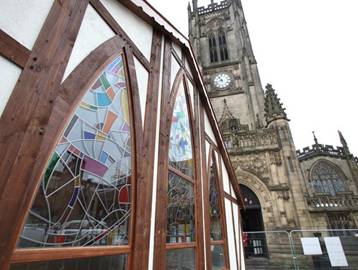 The proposed new heating system has been developed over the past two years by the Cathedral Architect, John Prichard, who has worked closely with Tim Bowden of service engineers Ramboll UK Limited. The structural engineers are Blackett-Ord Consulting Engineers.
The proposed new heating system has been developed over the past two years by the Cathedral Architect, John Prichard, who has worked closely with Tim Bowden of service engineers Ramboll UK Limited. The structural engineers are Blackett-Ord Consulting Engineers.
The architects report that work is progressing well: “The removal of the floors installed since the 1930s has required the use of a saw that cuts through the modern surface and into the concrete below. Bit by bit the floor has been divided into square sections that are lifted from the ground and disposed of.”
Before work began a wooden ‘pop-up’ cathedral, the Cathedral on the Street, was erected by Nikal UK and Innov8, allowing Sunday morning services to continue as normal, together with other major services and events.
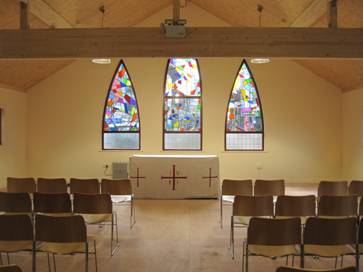 The new heating system is part of an on-going restoration programme of the cathedral and its precincts.
The new heating system is part of an on-going restoration programme of the cathedral and its precincts.
In addition to the repair and renovation of the roof and interior of the building the entrances will be opened up and the visitor centre reordered.
Inside the building the timber dais will be replaced with a mechanical dais that will rise from the new floor and important statues that were moved after the World War II bomb strike will be reinstated.
A new internal and external lighting scheme will address four ‘levels’: base, enhanced, local and feature lighting. A new organ will be installed and a series of contemporary pavilions will “activate public spaces and provide physical and visual linkages for arts, music and education”.
In the wider precincts, there will be improved exposure of the ancient Hanging Bridge Ditch, with new linkages to Victoria Arches and the Cathedral Visitor Centre.
Manchester Cathedral Development Project - A new heart for our city
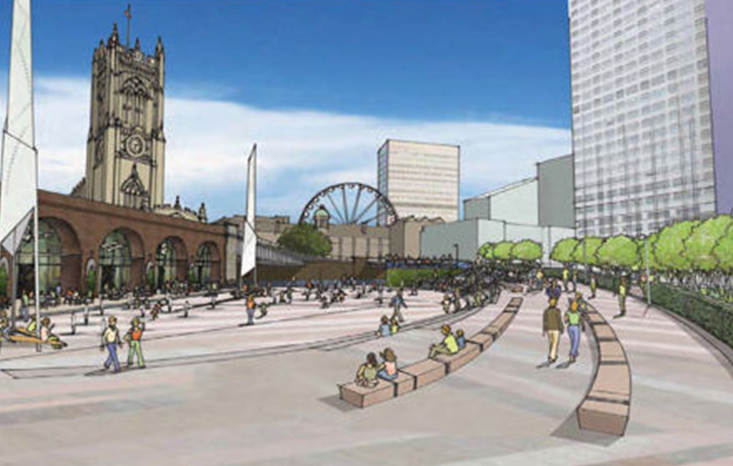 The renewal of the birthplace of Manchester and Salford will secure the Cathedral and its surrounds for this and future generations. The two key aspects to the renewal, with a focus on the Cathedral buildings and its environments, will be developed in a number of partnerships. These partnerships include donations from worshippers, trusts, foundations and strategic partnerships with government agencies and the cities of Manchester and Salford.
The renewal of the birthplace of Manchester and Salford will secure the Cathedral and its surrounds for this and future generations. The two key aspects to the renewal, with a focus on the Cathedral buildings and its environments, will be developed in a number of partnerships. These partnerships include donations from worshippers, trusts, foundations and strategic partnerships with government agencies and the cities of Manchester and Salford.
Once completed, the Cathedral buildings, with its improved facilities, secured buildings and music traditions, will sit in a new environment with its own sense of place and space.
This space will raise the public perception of the Cathedral and tell the untold story of medieval Manchester, becoming a new destination to those within the city and beyond.
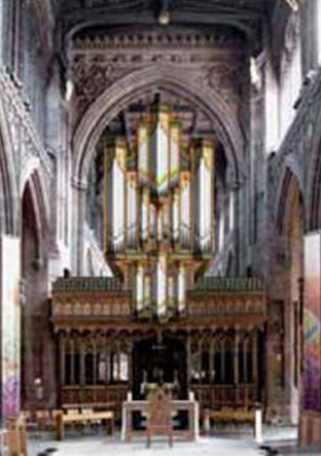 The vision incorporates the following key aspects:
The vision incorporates the following key aspects:
- Repair and renovate the Cathedral fabric, roof and interior of the building adding additional space to support the work of the Cathedral.
- Install a new organ (see concept drawing below) and establish a music endowment fund to support the wider musical life of the Cathedral and its partnership with Chetham’s School of Music.
- Amend the Cathedral boundary and soft landscaping to encourage social activity and amenity.
- Open up Cathedral entrances to improve visitor linkages and activate adjacent street environments.
- Create a coherent internal and external lighting scheme that will address four levels: these are base, enhanced, local and feature lighting.
- Reorder of the Cathedral Visitor Centre, creating additional entrances.
- Improve exposure of Hanging Bridge Ditch with new linkages to Victoria Arches and the Cathedral Visitor Centre.
- Regenerate Victoria Arches providing active river frontage.
- Create a series of contemporary pavilions that activate public spaces and provide physical and visual linkages for arts, music and education.
Be a part of it
You can participate in a number of ways:
• Join our team and help us deliver this exciting project. Email us at This email address is being protected from spambots. You need JavaScript enabled to view it. or call 0161 833 2220 for further information.
• Join the Society of St Denys
• Make a financial contribution online.
• Just TextGiving
It costs £120 an hour to run Manchester Cathedral - please help us by donating at least £3 towards maintenance, music and education.
If you would like to make a text donation to the Lighting fund, please text LITE12 followed by the amount you would like to donate, for example LITE12£10 to 70070. You will then automatically be given the choice to Gift Aid it.
If you would like to make a text donation to the Organ fund, please text ORGN12 followed by the amount you would like to donate to 70070. You will then automatically be given the choice to Gift Aid it.
If you would like to make a text donation to the Heating fund, please text HEAT12 followed by the amount you would like to donate to 70070. You will then automatically be given the choice to Gift Aid it.
Please note the maximum donation in one transaction is £10.
'Cathedral' is the word on the street!
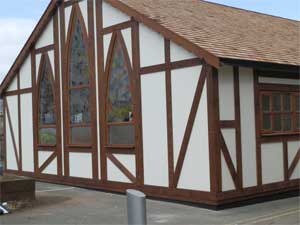 If you have walked along Victoria Street recently, you would have witnessed the construction of Manchester’s newest religious building – the Cathedral on the Street! The original Cathedral building will be in the hands of contractors from the 3 April until the end of November so that we can replace the heating system.
If you have walked along Victoria Street recently, you would have witnessed the construction of Manchester’s newest religious building – the Cathedral on the Street! The original Cathedral building will be in the hands of contractors from the 3 April until the end of November so that we can replace the heating system.
The current underfloor heating mechanism, which dates from the 1950s, is no longer efficient and is being exchanged for a more up-to-date energy-saving heating scheme. Ground source heat pumps that use natural energy stored in the earth will heat and cool the cathedral, making it one of the greenest in the UK.
The Very Reverend Rogers Govender, Dean of Manchester said, “ I am very pleased with all the work that CityCo and everyone else have done to develop the greenery on Victoria Street. These developments are very welcome as they will attract people into the area and will also make the area look beautiful, especially as we move into spring and the coming holiday season. I would like to thank everyone for their efforts.”
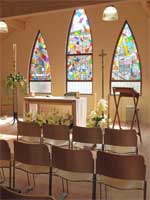 And regular Cathedral worshippers, visitors and those who find the Cathedral to be a place of peace and calm will not be cut adrift during this period when essential maintenance work has to be done. A ‘pop-up’ cathedral designed in conjunction with Manchester Cathedral and constructed and partly sponsored by Nikal Ltd has appeared in front of the old building’s west doors. The building’s design reflects elements of the Old Church, with simple long-arched, church-style windows with coloured leaded glass, a feature door canopy and oversized main door. The design also ‘nods’ to the many Tudor features around the area of the city, from Chetham’s School of Music to the Shambles. The Cathedral’s Sunday morning services will be held here, together with other major services and events, as the structure can hold up to 300 people. And the pop-up Cathedral will be open for prayer and reflection daily. So if you are passing, why not stop and have a look? Not only to visit the Country’s latest cathedral, but to visit a part of the city that is gradually being transformed into a green and pleasant land. This is because the pop-up cathedral is now part of the sixth Manchester Garden City Scheme and will sit alongside a city centre garden (featuring the city centre’s first children’s play area), plenty of new trees, ornamental flowers and allotment-style ‘Grow Boxes’ for residents and businesses to plant their own produce. The new space also includes artificial grass with new seating areas, and chalets to cater for community events and children’s activities. The scheme also sees the introduction of a new cycle lane, connecting Victoria Street to Greengate.
And regular Cathedral worshippers, visitors and those who find the Cathedral to be a place of peace and calm will not be cut adrift during this period when essential maintenance work has to be done. A ‘pop-up’ cathedral designed in conjunction with Manchester Cathedral and constructed and partly sponsored by Nikal Ltd has appeared in front of the old building’s west doors. The building’s design reflects elements of the Old Church, with simple long-arched, church-style windows with coloured leaded glass, a feature door canopy and oversized main door. The design also ‘nods’ to the many Tudor features around the area of the city, from Chetham’s School of Music to the Shambles. The Cathedral’s Sunday morning services will be held here, together with other major services and events, as the structure can hold up to 300 people. And the pop-up Cathedral will be open for prayer and reflection daily. So if you are passing, why not stop and have a look? Not only to visit the Country’s latest cathedral, but to visit a part of the city that is gradually being transformed into a green and pleasant land. This is because the pop-up cathedral is now part of the sixth Manchester Garden City Scheme and will sit alongside a city centre garden (featuring the city centre’s first children’s play area), plenty of new trees, ornamental flowers and allotment-style ‘Grow Boxes’ for residents and businesses to plant their own produce. The new space also includes artificial grass with new seating areas, and chalets to cater for community events and children’s activities. The scheme also sees the introduction of a new cycle lane, connecting Victoria Street to Greengate.
Vaughan Allen, Chief Executive at city centre management company CityCo said: “We are delighted to have worked with the Cathedral and other partners to create a new green space in the heart of the city centre for people to enjoy. The new garden around the pop-up church will be a pleasant, quiet oasis for people to take time out and relax.
For more information about the company responsible for the Pop Up Cathedral visit www.innov8ds.com
Green heat meets high tech meets the hallowed cloisters of Manchester Cathedral.
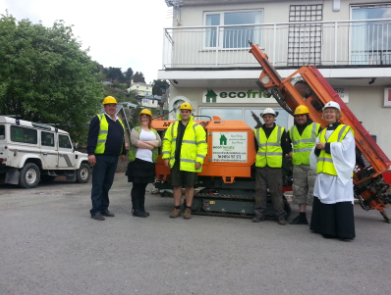 Reverend Christina ten Wolde, NSM cleric-in-charge of St Peter's Aberdyfi is seen blessing a robot drill rig and its crew as it prepares to leave the wilds of Snowdonia for ultra urban Manchester. This specially designed radial rig is almost ballet-like in its flexibility and lightness of footprint and therefore able to bring all the benefits of ground source heat to the most inaccessible of places - that could mean out in the wilds or in the middle of the concrete jungle.
Reverend Christina ten Wolde, NSM cleric-in-charge of St Peter's Aberdyfi is seen blessing a robot drill rig and its crew as it prepares to leave the wilds of Snowdonia for ultra urban Manchester. This specially designed radial rig is almost ballet-like in its flexibility and lightness of footprint and therefore able to bring all the benefits of ground source heat to the most inaccessible of places - that could mean out in the wilds or in the middle of the concrete jungle.
Its strength equals that of the big boys and it will drill the 1600m of heat extraction that will enable the ground source heat system that is part of the major revamp of Manchester Cathedral. Eco Friendly Installations is also concerned with the sustainabilty of its village - the drill crews, plumber, electrician, heat and geology assessor, system designer and admin staff who take these niche projects from drilling to complete fitting out of heat systems are all highly trained and MCS accredited local youngsters in an area where there are few full-time jobs.
"To thrive any village needs resident young families and I have been privileged to see most of the staff here grow up. I'm baptising another of their babies next month and we've had some lovely weddings. We had to sell our church hall some years ago to pay for work on the church roof but Eco Friendly has a beautiful conference room with state of the art loo and kitchen facilities and we hold our Messy Church, ecumenical bible study and prayer groups here in the evenings and at weekends. It's always lovely and warm!"
How Ground Source heating works
Ground Source Heat Pumps work by utilising the solar energy trapped in the earth as well as residual geothermal energy left over from when the planet was formed. In order to collect this heat, bores are drilled into the ground and pipes (or loops) inserted. These loops are then filled with water which is heated by the thermal energy. In Britain, the average temperature of the ground is around 8°C. Once the water has been heated to this temperature it is then pumped back to the Heat Pump where it is compressed - increasing the temperature so that it may be used for domestic hot water and heating.
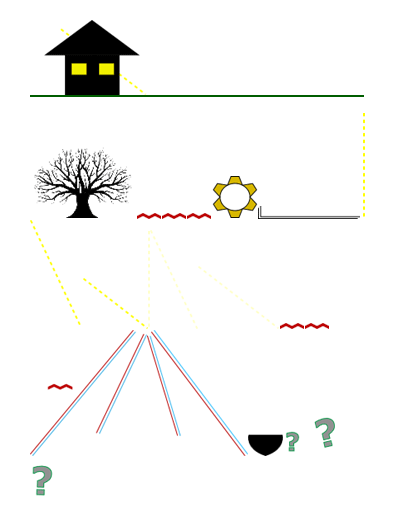
This radial method utilises the ground beneath existing properties making it a truly unique system. Since the bores are drilled at an angle, we are able to bore beneath properties or other existing obstacles without causing any damage to foundations which may exist.
For your information....
Heat Pumps are only able to produce a maximum of 45°c for central heating which is why underfloor heating is ideally suited to this type of system as it runs on much lower temperatures than traditional systems.
Traditional radiators must be oversized in order to work with renewable systems
Underfloor heating works best with ground source as it runs on a lower temperature.
Traditional radiators may also be used but they must be oversized in order to gain the same heat output whilst running at a lower temp. Another effective solution is to use convection heaters, these work with the lower temperatures to achieve the same heat distribution as a more traditional radiator system and can be controlled at the point of use much the same as traditional radiators.
What sort of heating system can be used with Ground Source Heat Pumps?
- Underfloor Heating
- Traditional Radiators
- Convection Heaters
For more information on this and other heating methods for your church or listed building visit www.ecofriendlyinstallations.com























